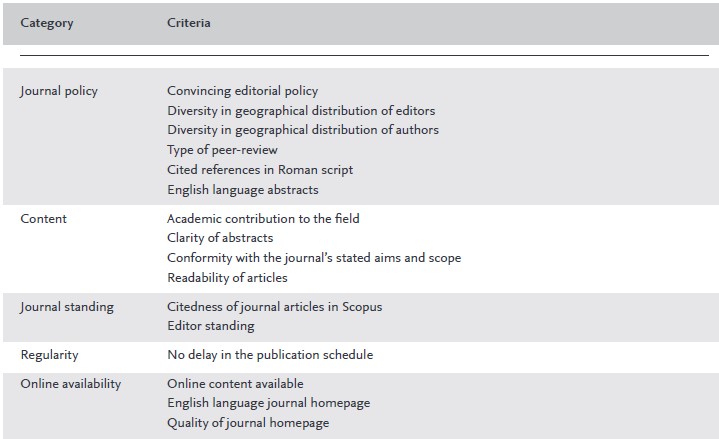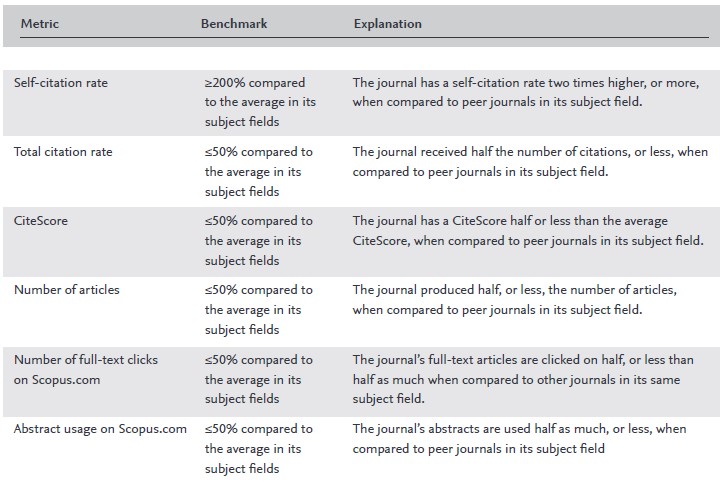Criteria For Title Selection & Re-evaluation in Scopus
Criteria For Title Selection & Re-evaluation in Scopus
It is estimated that there are between 80,000 and 300,000 scientific serial publications in existence worldwide. In order to ensure that Scopus remains the most relevant resource for all research in the sciences, technology, medicine, social sciences and arts and humanities fields, the CSAB continually reviews new titles for inclusion, using transparent selection criteria (see https://www.elsevier.com/solutions/scopus/content/content-policy-and-selection). New title suggestions may come from librarians, publishers and journal editors and can be submitted using the Title Suggestion form on the Scopus info site: http://suggestor.step.scopus.com/suggestTitle.cfm. Scopus receives approximately 3,300 serial title suggestions on an annual basis. The number of suggested titles can vary significantly per subject area from only a few titles (e.g., in chemistry) to several hundred (e.g., in social sciences).
Criteria for title selection Titles should meet the following main eligibility criteria to be considered for review:
• Consist of peer-reviewed content
• Be published on a regular basis (have an ISSN number that has been registered with the International ISSN Centre)
• Be relevant and readable for an international audience (e.g., have references in Roman script and English language abstracts and titles)
• Have a publication ethics and publication malpractice statement CSAB subject matter experts review titles using both quantitative and qualitative measures, and the selection is partly based on sample documents from the title.
The criteria that will be used in the review process are grouped in five main categories: journal policy, content, citedness, regularity and online availability. These criteria can be found on the Scopus info site: http://www.elsevier.com/solutions/scopus/content/content-policy-and-selection. The Scopus Title Evaluation Platform (STEP) (see below) enables the CSAB members to evaluate and add new titles on a continuous basis and to establish reliable turnaround.

Title re-evaluation
Curation of the data already covered in Scopus is no less important than the selection of content. Many journals benefit from the increased visibility and accessibility of their content through the global reach and use of Scopus, and we have observed this through an increase in output, citation and usage. However, there are also journals that alter their editorial policies and publishing standards and underperform over time. As an incentive for journals to maintain their high content quality, Scopus annually re-evaluates low-performing journals based on a set of metrics and benchmarks and in comparison to peer journals in their subject fields. The set metrics and benchmarks which all journals in Scopus have to meet in order to not be re-evaluated are:

Journals receive a pre-warning if they do not meet any of the six set benchmarks and have a one-year period to improve in at least one metric. If after the one-year period the journal has not improved in at least one of the metrics, the journal is re-evaluated by a CSAB member based on the transparent title selection criteria (see above) with the possible consequence of the journal its forward flow being discontinued on Scopus.
Content Selection & Advisory Board Subject Chairs
The Content Selection & Advisory Board comprises 17 subject chairs who are senior researchers, experienced in editorial roles, and are responsible for reviewing all the serial titles within a specific subject area. The subject chairs have the clear ownership per title in their respective area, and are ultimately responsible for the final vote as to whether a new journal title is included on Scopus. Subject chairs can choose to either:
• Reject/accept the submitted title based on his/her own judgment according to the Content Coverage Policy (see section 4.2: Scopus title evaluation ), or
• Involve additional reviewers, who have the respective subject expertise and/or the language skills required to read and evaluate journals publishing in languages other than English
Scopus Title Evaluation Platform
The Scopus Title Evaluation Platform (STEP) is a web-based editorial system, streamlining the entire title evaluation process from submission until the final decision, including the feedback to the suggestor and publisher/ editor of newly suggested titles. STEP offers several benefits, including:
• Those suggesting new titles receive feedback on why their title was accepted or rejected via a consistent process of communication
• Shorter decision-making cycle
When are new titles selected by the Content Selection & Advisory Board added to Scopus? Once a title is accepted for inclusion in Scopus, the Elsevier Bibliographic Databases Operations department will contact the publisher in order to set up the content feed. After the content feed has been set up, it will take up to a few weeks before the title will be added to Scopus. As per the above section on title re-evaluation, Scopus will, on an annual basis, curate the journal quality of all titles in the database.
download the article, click here
